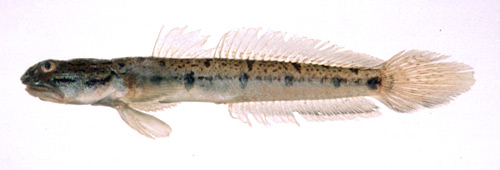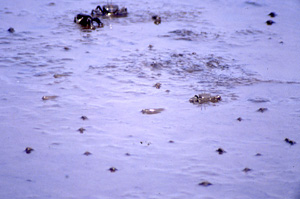Common names:
China |
Chinese Mandarin |
斑叉牙虾虎魚, 斑叉牙鰕虎鱼 (ban cha ya xia hu yu - spotted branch-teethed goby) |
Finland |
Finnish |
Japaninkitaryömijä |
Italy |
Italian |
saltafango punteggiato* |
Taiwan |
Chinese |
短斑臥齒鯊 (duan ban wo chi sha - short-blotched flat-teethed shark) |
* proposed name
|

Apocryptodon punctatus. Ako, Hyogo Pref., Japan
lateral view - freshly dead specimen
(photo: T. Suzuki, 1993; fishbase)
|
|
Synonyms:
Apocryptodon punctatus |
Tomiyama, 1934 |
(senior synonym, original combination) |
Etymology:
the generic name is a compound form from 'Apocryptes' and the Greek 'odous' (tooth), which refer to the similarity to the oxudercine genus Apocryptes and to the conspicuous teeth on the upper jaw
'punctatus' means 'spotted' in Latin, which refers to the specific colouration pattern
|
Maximum recorded length:
67 mm SL (Murdy, 1989)
Live colouration (Murdy, 1989):
ground colour dorsally greenish, and silvery ventrally; a longitudinal dark stripe can be
visible, coursing from below eye, across cheeck and opercle, above pectoral fin base,
and up to the caudal peduncle; 5-6 dark blotches may be visible midlaterally; many
scattered tiny black speckles on flanks and dorsum; fins mostly transparent: D2 with
small dusky spots basally; caudal fin proximally dusky, ventrally blackened, with orange
tint dorsally; anal fin with posterior elements partly blackened; pelvic rays proximally
orange; pectoral fins with orange tint proximally and slight blackening inframarginally
along ventral edge
Colouration on preservation:
ground colour pale brown; spots, bars and lines brown; dorsal, caudal and pelvic fins transparent;
anal fin elements distally dusky; pectoral fins with only a dusky band inframarginally along ventral edge
Diagnosis (Murdy, 1989):
predorsal scales 22-23; 5-6 vertical, narrow brown bars (see above).
This genus is characterised by posteriorly directed lamina on the parapophyses
of the 4th vertebra and the presence of a supraorbital pore (see drawings)
Diet:
the only available data are from Dotsu, 1961 (in Japanese)
Reproduction:
the only available data are from Dotsu, 1961 (in Japanese)
|
|
Ecological notes:
it lives near river mouths, on unvegetated, temperate open mudflats, in burrows dug by pistol shrimps of the genus Alpheus
(Dotsu, 1961,
cited in Murdy, 1989); in the Ariake Sound this species is frequently captured by shrimp commercial nets (Toru Takita, pers. comm.)
middle: open mudflat during low tide, a typical habitat of A. punctatus in the Ariake Sound (Tojin river, Kyushu, Japan, 1993; photo courtesy of Toru Takita)
|

|
|
|
Distribution:
Southern Japan; type locality: Kyushu, Japan (Murdy, 1989)
|
|
Remarks:
Koumans (1953) synonymised A. punctatus Tomiyama with An. madurensis (Bleeker), while Murdy (1989) considered both as a valid species
|
Photographs of Apocryptodon punctatus:
|
A, B: close-ups of A. punctatus in aquarium
(photo: T. Mukai, 2006), with permission
|
Drawings of Apocryptodon punctatus:
left: cephalic sensory and nasal pores of Apocryptodon spp.: an= anterior nostril;
ao= anterior oculoscapular canal pore; pn= posterior nostril; sp= supraorbital pore
(modified from Murdy, 1989)*; right:
dorsolateral view of the parapophyseal extension of the 4th vertebra (An. madurensis:
Murdy, 1989, modified)* - * with permission
|





